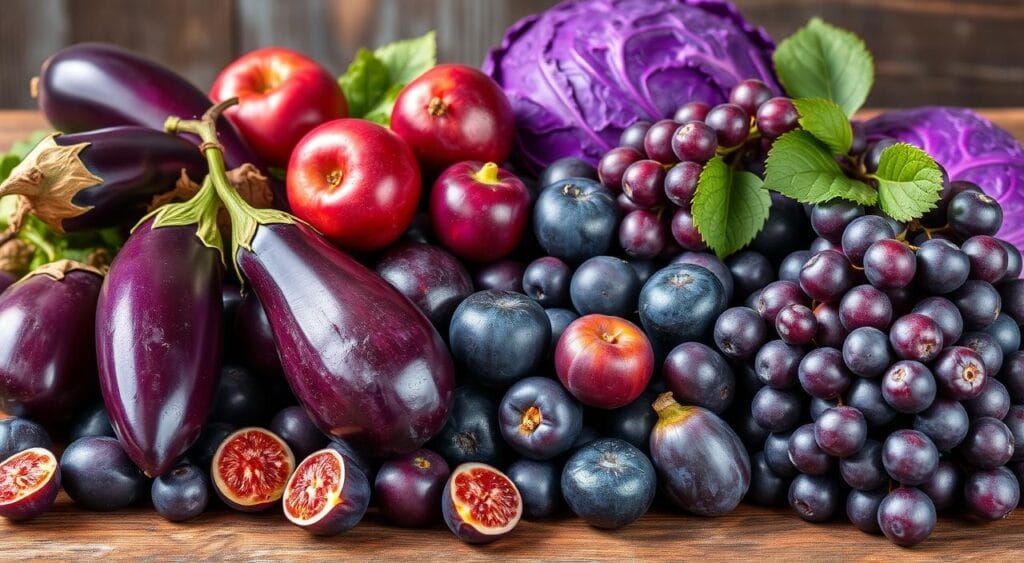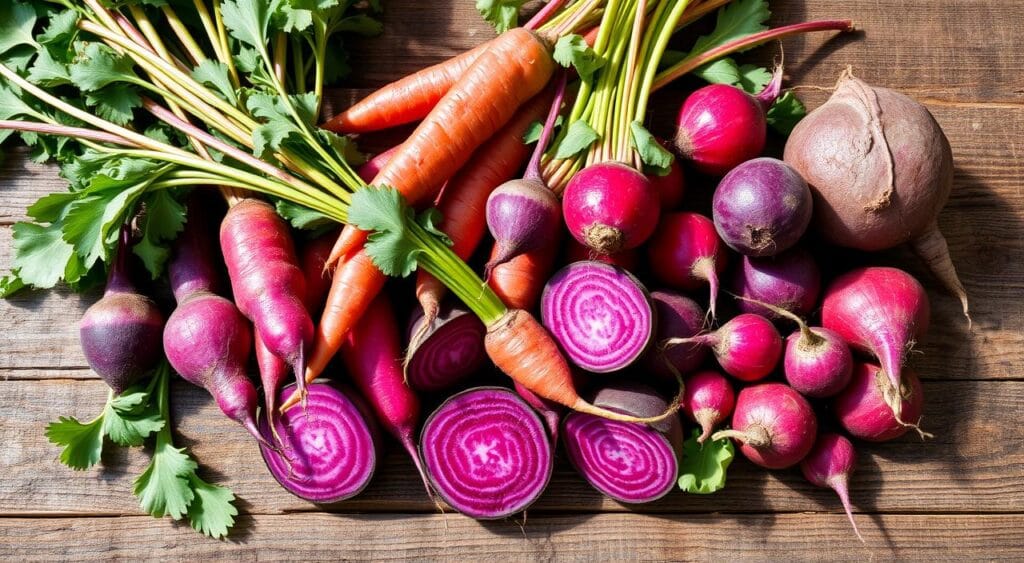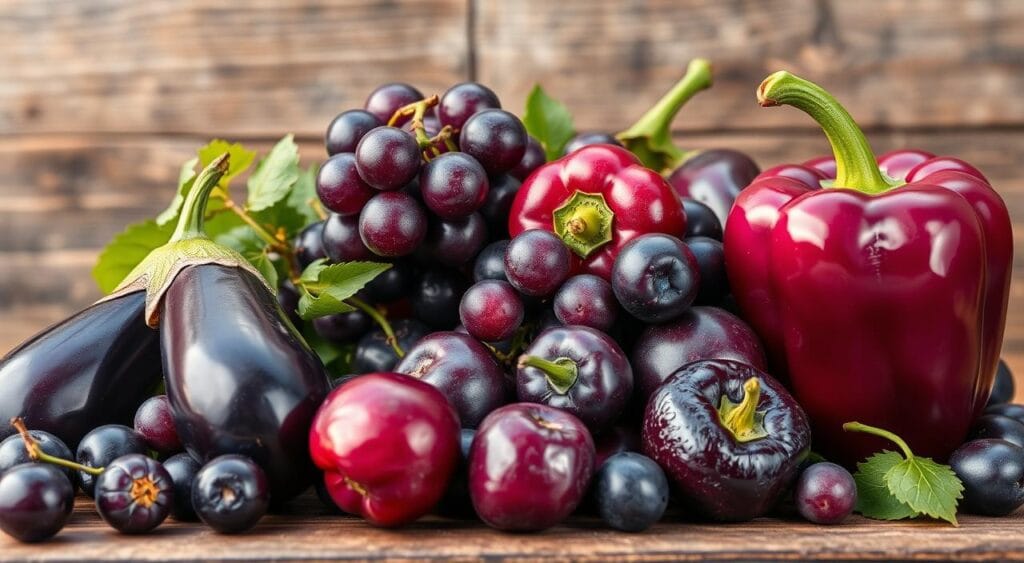Table of Contents
In the colorful world of fruits and veggies, purple ones catch our eye. They offer a special mix of nutrients. This guide takes you on a trip to learn about purple foods, their health perks, and how to add them to your meals.

Key Takeaways
- Discover the diverse array of purple fruits and vegetables and their unique nutritional profiles.
- Understand the science behind the powerful antioxidants found in purple produce and their health-boosting effects.
- Explore the wide range of purple fruits and vegetables available in local markets and their seasonal availability.
- Learn about the exceptional nutritional benefits of purple root vegetables, leafy greens, and other vibrant produce.
- Uncover cooking tips, recipe ideas, and strategies for growing your own purple fruits and vegetables at home.
Understanding the Power of Purple Foods in Your Diet
Explore the world of purple fruits and vegetables. Their vibrant colors come from anthocyanins, powerful antioxidants. These pigments not only color the food but also bring health benefits to your diet.
The Science Behind Purple Pigments
Anthocyanins are key for purple, blue, and red colors in plants. They are found in purple root vegetables, berries, and leafy greens. These antioxidants help protect against oxidative stress and inflammation, which can lead to chronic diseases.
Key Antioxidants in Purple Foods
- Anthocyanins: These powerful pigments are the main attraction. They offer benefits of purple vegetables like better heart health, reduced inflammation, and improved brain function.
- Vitamin C: Purple fruits and vegetables are also rich in vitamin C. This vitamin is essential for immune function and maintaining healthy skin.
- Carotenoids: The bright colors of purple produce come from carotenoids. These compounds promote eye health and protect against some cancers.
Health-Boosting Properties
Purple foods are packed with antioxidants and phytochemicals. Adding them to your diet can lower heart disease, diabetes, and cancer risks. They also support brain function and gut health.
“Eating a variety of colorful fruits and vegetables, including purple produce, is one of the best ways to ensure you’re getting a wide range of beneficial plant compounds in your diet.”

Common Purple Fruits and Vegetables in Your Local Market
Exploring purple produce at your local market is a fun adventure. You’ll find everything from eggplants to plums. These foods are not only colorful but also packed with nutrients and unique tastes.
Eggplants are a great example of purple produce. They have a rich purple skin and a creamy inside. You can roast, grill, sauté, or bake them. Their mild flavor is perfect for Mediterranean and Middle Eastern dishes.
Plums are another purple fruit you’ll see. They’re juicy and sweet, full of antioxidants, vitamins, and fiber. Choose plums with a bright purple skin and a soft feel when you press them.
Blackberries are a purple fruit powerhouse. They’re small but full of nutrients. Enjoy them fresh, in salads, or smoothies for a healthy treat.
Purple cabbage is also a must-try. It’s vibrant and crunchy, adding flavor to slaws, stir-fries, and roasted vegetables. Its mild taste goes well with many dishes, making it a great addition to your cooking.
When you visit your local market, look for these purple foods. Adding them to your diet can make your meals healthier and more colorful.

Nutritional Benefits of Purple Root Vegetables
Exploring purple root vegetables reveals a world full of nutritional benefits. These vibrant foods offer unique properties that can boost your health and wellbeing.
Purple Potatoes and Their Unique Properties
Purple potatoes add a stunning touch to any meal. They are packed with anthocyanins, powerful antioxidants that fight oxidative stress and inflammation. Plus, they are rich in fiber, vitamins, and minerals, making them a great choice for your diet.
Purple Carrots: Ancient Varieties Rediscovered
Purple carrots are making a comeback, thanks to their vibrant color and nutritional value. These heirloom carrots were once popular but fell out of favor. Now, they’re back in the spotlight for their carotenoids, which support eye health and have antioxidant properties.
Purple Yams: A Nutritional Powerhouse
The purple yam, or ube, is a true nutritional powerhouse. It’s loaded with anthocyanins and vitamin C. These tubers are not only beautiful but also offer health benefits like boosting immunity and improving digestion.
Adding purple vegetables to your diet is a tasty way to improve your health. They bring vibrant colors, unique flavors, and impressive nutritional benefits to your meals. Try incorporating these root vegetables to enjoy their health-boosting properties.
Purple Leaf Vegetables: From Garden to Table
Explore the world of purple leaf vegetables and how to use them in your cooking. These greens, like kale and red cabbage, are not just colorful. They’re also full of nutrients.
Purple kale is a standout. It adds color and nutrients to your meals. Its sweet and peppery taste is great in soups and salads.
Red cabbage is another gem. It’s perfect in slaws and pickles. It’s crunchy, sweet, and full of vitamins and fiber.
Purple basil adds elegance to your dishes. It’s great in pasta and salads. It brings a unique flavor and look to your food.
| Purple Leaf Vegetable | Culinary Uses | Nutritional Highlights |
|---|---|---|
| Purple Kale | Salads, stir-fries, soups | High in antioxidants, vitamins A and C |
| Red Cabbage | Slaws, pickles, roasted | Rich in vitamin C, fiber, and antioxidants |
| Purple Basil | Pasta dishes, salads, garnishes | Flavorful herb with anti-inflammatory properties |
Bring the beauty and health of purple leaf vegetables into your kitchen. Use them in salads, soups, or roasted dishes. They’ll make your meals colorful and nutritious.
Seasonal Guide to Purple Fruits and Vegetables
Exploring purple fruits and vegetables is a fun way to eat seasonal. Spring and summer offer juicy plums and sweet grapes. Fall and winter bring purple potatoes and radishes.
Spring and Summer Purple Produce
When it gets warmer, markets fill with purple treats. Enjoy juicy plums, tart blackberries, and sweet grapes in summer. Purple cauliflower, eggplants, and purple asparagus add flavor to your dishes.
Fall and Winter Purple Harvest
Fall brings purple potatoes, purple carrots, and purple cabbage. They’re great in soups and roasted dishes. Winter offers purple Brussels sprouts, purple radishes, and purple sweet potatoes for vibrant meals.
Year-Round Availability
Some purple fruits and vegetables are always available. Purple onions, purple kale, and purple bell peppers are perfect for many dishes. They add color and flavor to your meals.
This guide helps you find seasonal produce and enjoy purple fruits and vegetables all year. It’s a great way to add variety and health to your diet.
Cooking Tips and Recipe Ideas for Purple Foods
Adding purple fruits and vegetables to your meals can make them taste great and be super healthy. You can make everything from savory dishes to sweet treats with these ingredients. Here are some cooking tips and recipe suggestions to help you get started.
Culinary Uses of Purple Fruits and Vegetables
Purple foods are great for both savory and sweet dishes. Try them in:
- Roasted purple potatoes or sweet potatoes for a side dish or base for a hearty meal
- Purple cabbage slaw or salad for a crunchy, colorful addition to your plate
- Blended purple cauliflower or beets for a vibrant, nutrient-dense soup or puree
- Grilled or sautéed purple eggplant as a flavorful main course or side
- Baked purple carrots or parsnips for a naturally sweet, caramelized accompaniment
- Purple berries, such as blackberries or acai, in smoothies, desserts, or as a topping
- Purple grapes or plums in salads, sauces, or as a refreshing snack
There are countless ways to use these stunning purple fruits and vegetables in your cooking.
Preserving the Color and Flavor of Purple Produce
To keep purple produce looking and tasting great, follow these tips:
- Avoid overcooking: Purple pigments and antioxidants are sensitive to heat. Use gentle cooking methods like roasting, steaming, or sautéing to keep their colors and nutrients.
- Add lemon or vinegar: A bit of acid, like lemon juice or vinegar, helps keep purple foods from turning brown or gray while cooking.
- Freeze with care: Blanch purple fruits and vegetables before freezing to keep their color and flavor. Then, store them in airtight containers to prevent oxidation.
By following these tips, your purple produce will stay vibrant and delicious in your dishes.
Growing Purple Fruits and Vegetables in Your Garden
Are you fascinated by purple produce? Why not grow your own purple fruits and vegetables? This guide is for both seasoned gardeners and newcomers. It offers tips to grow these stunning, nutritious crops.
Best Climate Conditions
Purple fruits and vegetables love temperate climates with plenty of sunlight. Purple root vegetables, like purple potatoes and carrots, do well in cool, moist soil. Purple leaf veggies, like kale and cabbage, can handle a variety of climates. Knowing your purple produce’s climate needs is key to a great harvest.
Soil Requirements and Care Tips
Good soil is vital for vibrant purple crops. Purple root veggies, such as sweet potatoes, need well-draining, loamy soil. Add compost or manure to enrich the soil. Purple leaf veggies prefer slightly alkaline soil with plenty of moisture. Keep the soil moist and weed regularly for the best results.
Common Growing Challenges
- Pests and diseases can be a challenge when growing purple produce. Use row covers or natural repellents to fight pests.
- Ensuring adequate sunlight exposure is crucial for maintaining the vibrant purple hues in your crops. Choose the right spot for your plants to get enough sun.
- Proper timing and crop rotation are important to prevent soil depletion and ensure continued success with your purple produce. Rotate your purple crops with other plants to keep the soil healthy.
Understanding purple produce’s needs and challenges can help you grow them successfully. Enjoy the vibrant colors and health benefits of your homegrown purple produce!
Storage and Preservation Methods for Purple Produce
Keeping purple fruits and vegetables fresh is key to enjoying their health benefits all year. There are many ways to do this, like refrigeration, freezing, and canning. These methods help keep your purple produce fresh for longer.
Refrigeration for Short-Term Storage
For quick use, put purple fruits and veggies in the fridge. They usually last a week in the crisper drawer. Make sure to clean and dry them well before storing to avoid spoilage.
Freezing for Long-Term Preservation
Freezing is great for keeping purple produce fresh for a long time. Blanch items like purple potatoes and carrots before freezing to keep their color. For fruits, just wash, slice, and freeze them quickly on a baking sheet. Then, put them in airtight containers or bags.
Canning for Year-Round Enjoyment
Canning is a good way to keep purple fruits and veggies for up to a year. Make sure to follow safe canning steps. This includes sterilizing jars and using the right processing times and temperatures. This way, your purple produce stays good and safe for a long time.
| Preservation Method | Recommended Items | Shelf Life |
|---|---|---|
| Refrigeration | Purple carrots, purple potatoes, purple cabbage | Up to 1 week |
| Freezing | Purple sweet potatoes, purple cauliflower, purple berries | Up to 1 year |
| Canning | Purple plums, purple eggplant, purple onions | Up to 1 year |
Learning these storage and preservation methods lets you enjoy purple fruits and veggies all year. Their vibrant colors and nutritional benefits will be available to you whenever you want.
Conclusion
Purple fruits and vegetables are full of nutrients and antioxidants. They offer many health benefits. Adding them to your diet can greatly improve your well-being.
We’ve looked into the science behind purple pigments and the nutrients they contain. We’ve also shown how to find, cook, and keep them fresh. Eating purple foods can add color, flavor, and nutrition to your meals.
Keep exploring purple fruits and veggies to make your diet healthier. Try new recipes and cooking methods. Enjoy the benefits of purple foods and see how they can improve your health and happiness.
FAQ
What are the health benefits of purple fruits and vegetables?
Purple fruits and vegetables are full of antioxidants, like anthocyanins. These can lower inflammation, help your heart, and improve brain function. They also offer fiber, vitamins, and minerals.
How do the antioxidants in purple produce work?
The purple pigments in these foods, called anthocyanins, are strong antioxidants. They fight off harmful free radicals in the body. This protects cells and supports health.
What are some common purple fruits and vegetables?
Popular purple foods include eggplants, plums, blackberries, and purple cabbage. Also, purple potatoes, carrots, and yams are favorites.
How can I incorporate more purple produce into my diet?
Adding purple fruits and vegetables is easy. Try purple smoothies, roast purple root veggies, or make purple coleslaw. Sauté purple leafy greens too. Be creative and try different purple foods.
Are there any specific growing tips for purple fruits and vegetables?
When growing purple produce, ensure the right climate and soil. Also, give them proper care to keep their color vivid. Watch out for pests and diseases that can harm the plant’s color.
How can I best store and preserve my purple produce?
To keep your purple fruits and vegetables fresh, store them in the fridge. Consider freezing, canning, or pickling. Proper storage helps keep your purple produce fresh longer.

